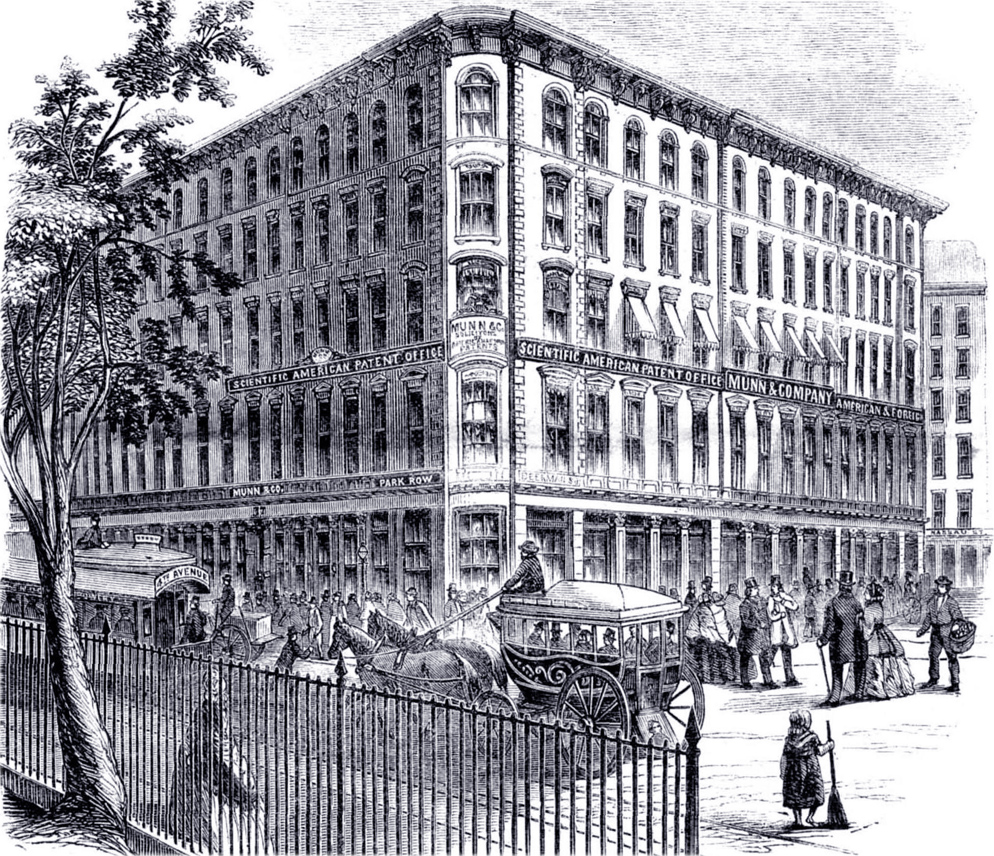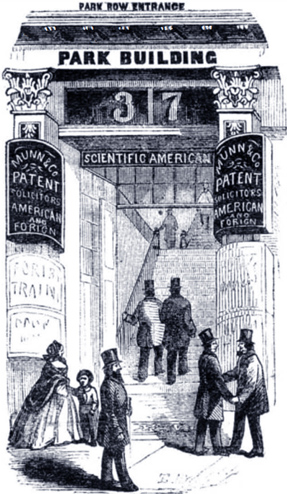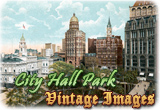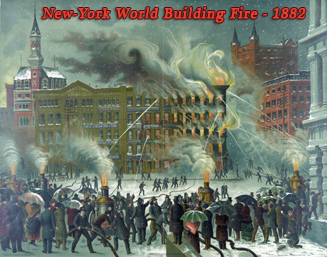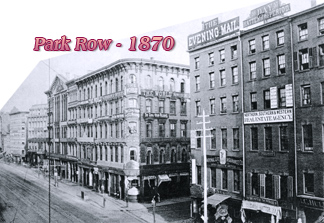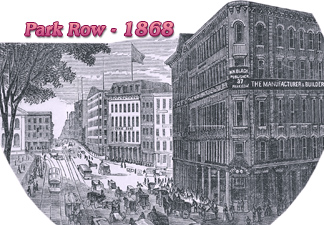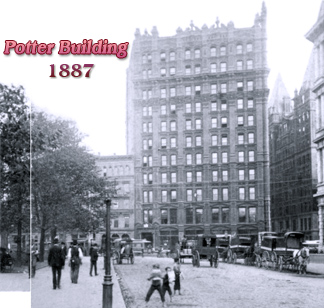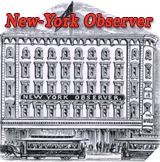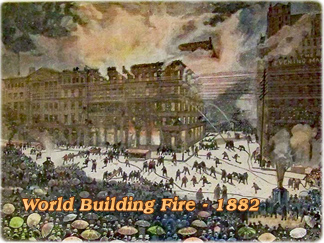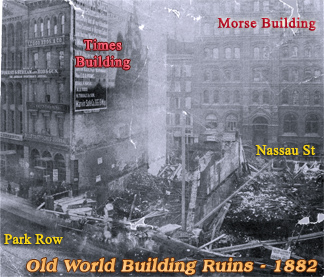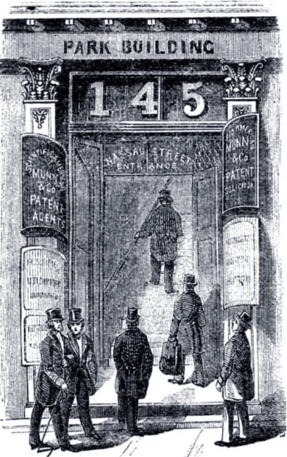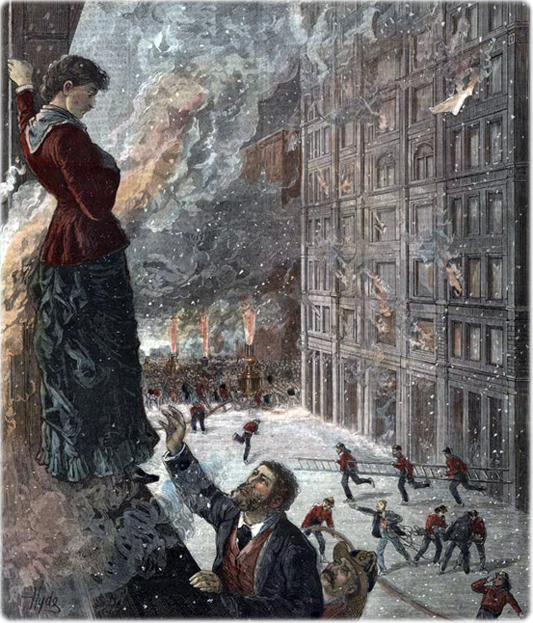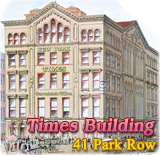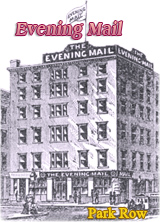The old five-story building at 37 Park Row was constructed by Orlando Brunson Potter (1823–1894) in 1857, on the site of the
Old Brick Church, sold at auction
on May 14, 1856 and demolished from March 14 to late April, 1857.
It was originally called Park Building, later World Building
(the old one) and sometimes, Potter Building (also the old one).
The site of Brick Church was shared by the Park Building (southern part at Beekman Street) and the Times Building (northern part at Spruce Street). Park Building was built of brown sandstone. It faced on Park Row, Beekman Street and Nassau Street. There were two entrances to the building: one at 37 Park Row and the other at 145 Nassau Street. The Scientific American (April 16, 1859) wrote about this building:
...after examining various prominent points with a view to a new and more eligible location, on the 1st day of February last [1859], we settled down in the new "Park Building," an external view of which adorns our front page [illustration above]. From its central position and combined advantages of excellent light and agreeable prospect, fronting as it does upon the City Hall Park, it is not too much to say that it is one of the finest business locations to be found in any city in the world. The building itself, as will be seen by reference to the engraving, is a magnificent structure running along 93 feet on Park-row, 144 feet on Beeckman street, and 86 on Nassau street, affording the rare advantage of three street fronts. It adjoins the ''New York Daily Times Building," which is, without exception, the most splendid and complete daily newspaper establishment in existence. These two buildings combined occupy the ground on which formerly stood the famous "Old Brick Church,...
The Park Building was the first headquarters of the newspaper New York World, established in 1860. It was burned down on January 31st, 1882, when many newspapers referred to it as the "old World Building". However, the newspaper left the building in 1881, when it was considered to be a trap. The walls were of stone, but the interior was constructed wholly of wood. Tons of papers were stored inside the building.
The building was also home to the New York Observer, from 1859 to 1882. It was founded in 1823 by Sidney Edwards Morse and his brother Richard Cary Morse, brother of telegraphy pioneer Samuel Morse. It eventually became the oldest weekly in New York City (another The New York Observer was founded in 1987). S.E. Morse continued as senior editor and proprietor of the journal until 1858, when he retired. Part of the offices and press-room of the New York Observer were housed in its former headquarters at 138 Nassau Street, which was also former headquarters of the New York Times.
In addition to the New York World, Scientific American and the Observer, the building also housed other offices (at different times) such as the Scottish American Journal and the Turf, Field & Farm, a weekly newspaper, Munn & Co. (patent agency), the Manufacturer and Builder (journal), Journal of Mining, the Coal and Iron Record, H. N. Black Publisher and others.
On February 1, 1882, the New-York Tribune wrote:
Burning of the Potter Office Building – At least six lives known to have been lost and the list probably to be extended – Terrible scenes while occupants were trying to escape - Two leaping to the sidewalk and fatally injured – Others suffocated or burned – A badly constructed building – The loss of property nearly a million dollars.
...Several of the large buildings close by were damaged. The burned building was owned by Orlando B. Potter, and was formerly known as The World Building, when occupied by that paper...
The building which was burned was occupied daily by from 200 to 300 men, women and children. They were employed in the various offices which were scattered through the five floors. Some of them began to arrive as early as 7 o'clock, ...It was about 10:15 o'clock when the alarm was given...The division of the fifth floor fronting on Beekman-st., formerly occupied as The World composing and editorial rooms, was vacant...
...A torrent of fire was soon driven by the wind across Beekman-st., full against the two buildings opposite - the old Mail Building [saved], fronting on Park Row, and the large unfinished structure owned by Eugene Kelly [saved], which fronts on Nassau -st.
[Statements of O.B. Potter, the owner]...I complied with all the requirements of the Buildings and Fire Departments, as I can amply prove...About the year 1856, I think, I put up the building which has been burned. It was known atone time as the Park Building, and more recently as The World Building...About the year 1858, The World came in, and remained there until recently... I shall rebuild, though I have no idea now what kind of a building I shall put up...
According to A. Costello (Our firemen: a history of New York Fire Department by A. Costello, 1887), about the fire, "It did more than $400.000 damage, and twelve persons were in various ways killed."
The Evening Critic (Washington, D.C.), January 31, 1882, reported that the NY Times Building, Morse building and a ten stories high building, opposite the World Building [Court Building], were also in flames by 11 a.m. The firemen were getting some control of the flames by 11:12. The World Building was condemned a year ago. The Times Building was saved with some damaged.
The site is now occupied by the 11-story Potter Building, erected from 1883 to 1886, designated a New York City landmark in 1996.
More: Park Row in 19th Century ►
